Abstract
Microsatellites are tandem repeat sequences abundant in the genomes of higher eukaryotes and hitherto considered as "junk DNA." Analysis of a human genome representative data base (2.84 Mb) reveals a distinct juxtaposition of A-rich microsatellites and retroposons and suggests their coevolution. The analysis implies that most microsatellites were generated by a 3'-extension of retrotranscripts, similar to mRNA polyadenylylation, and that they serve in turn as "retroposition navigators," directing the retroposons via homology-driven integration into defined sites. Thus, they became instrumental in the preservation and extension of primordial genomic patterns. A role is assigned to these reiterating A-rich loci in the higher-order organization of the chromatin. The disease-associated triplet repeats are mostly found in coding regions and do not show an association with retroposons, constituting a unique set within the family of microsatellite sequences.
Full text
PDF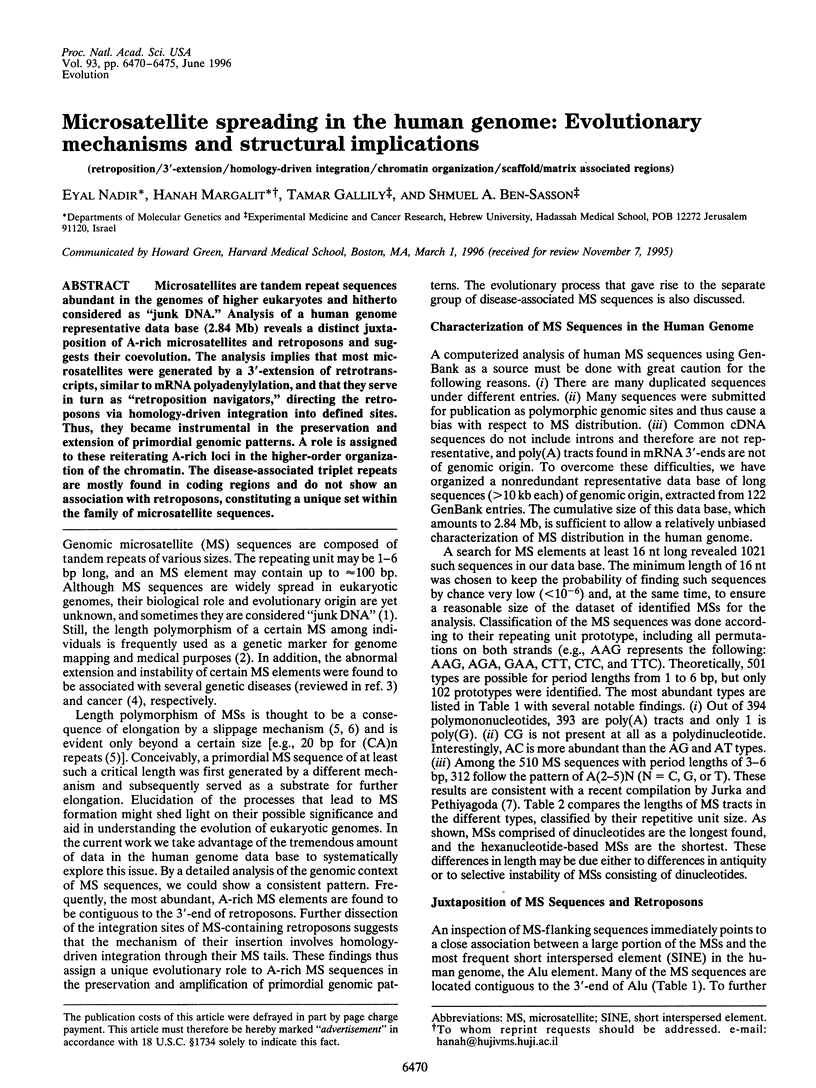
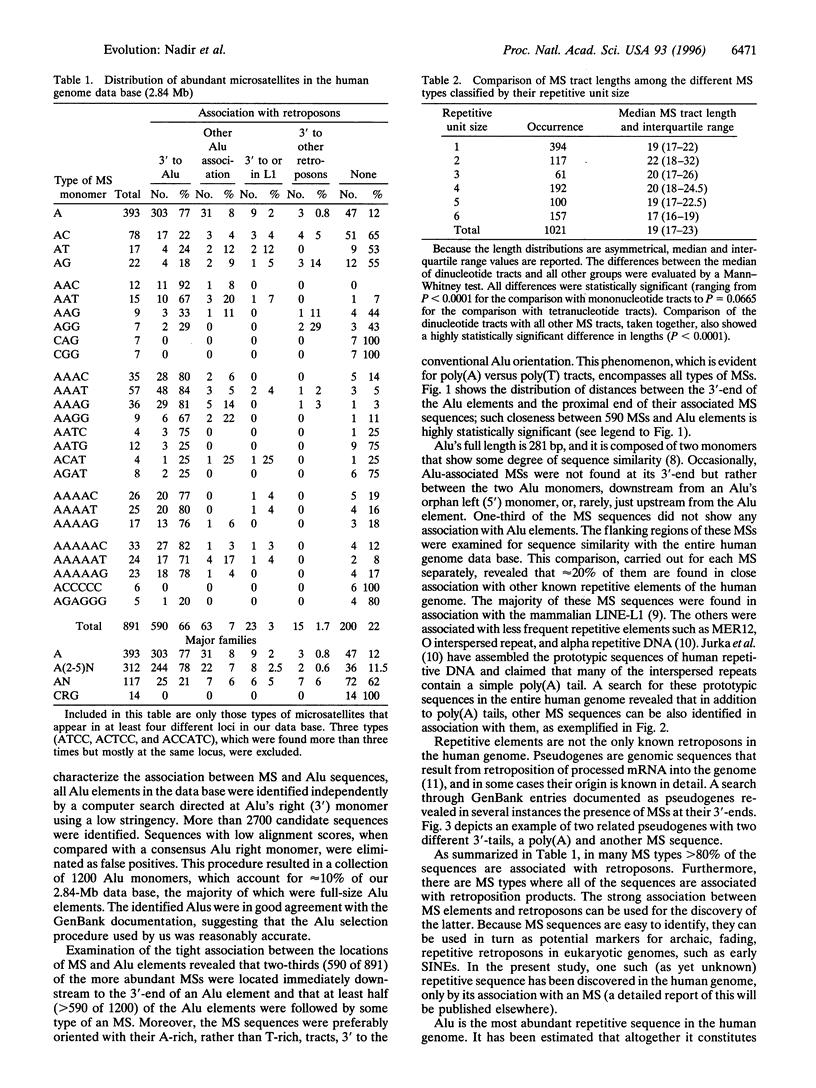
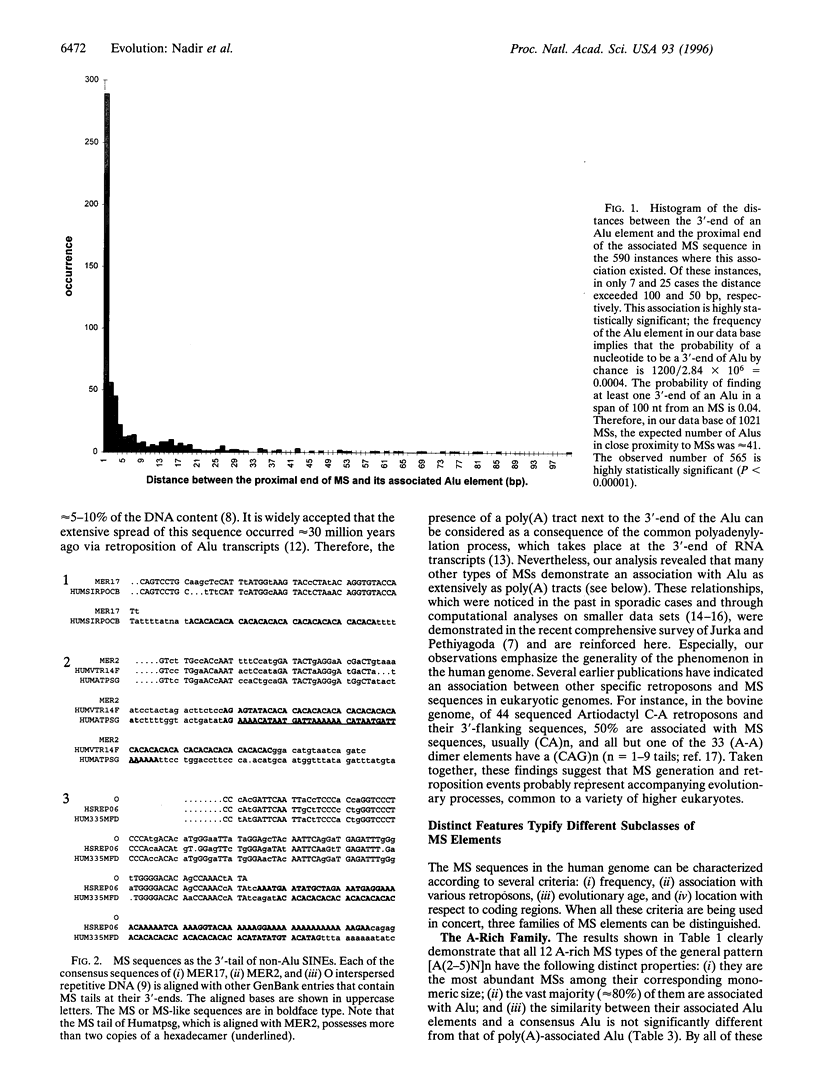
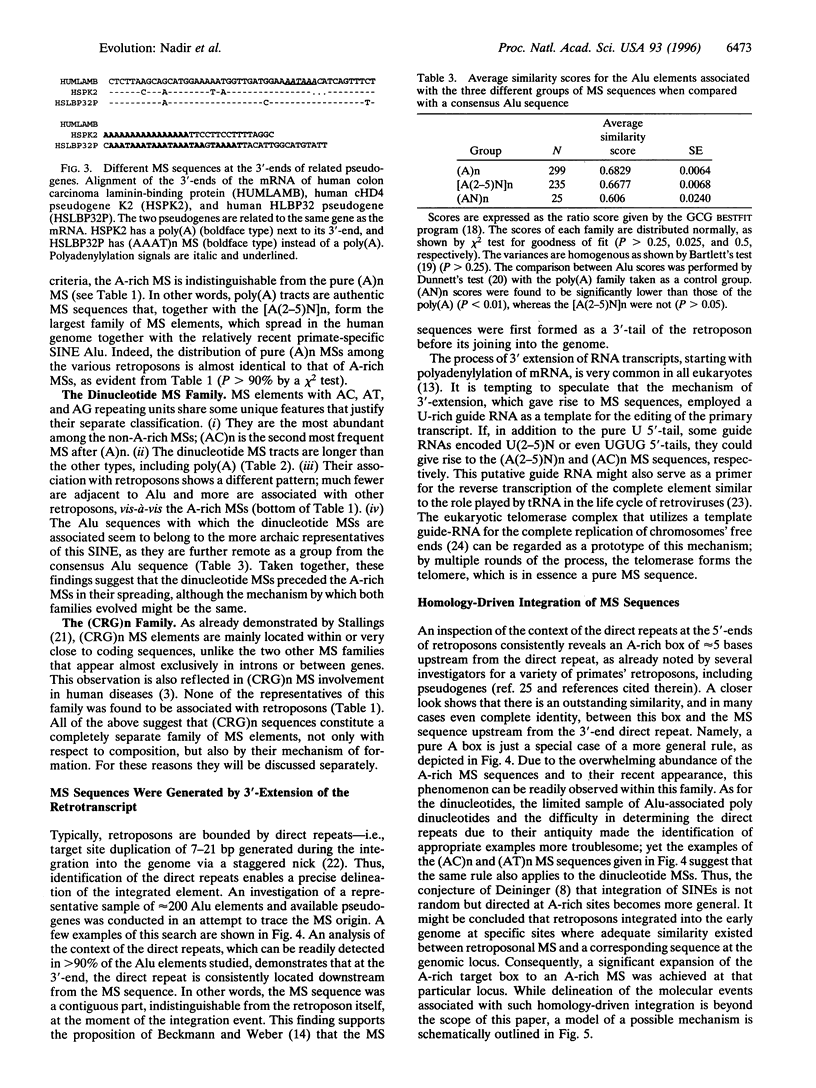
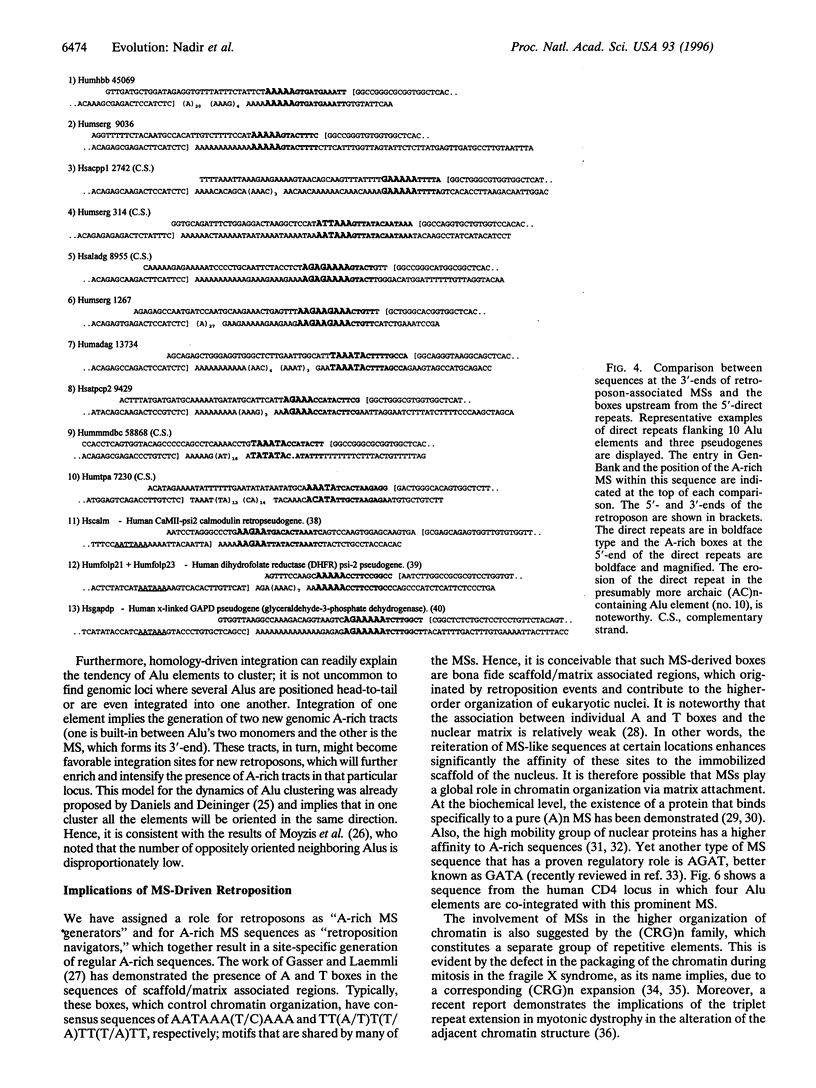
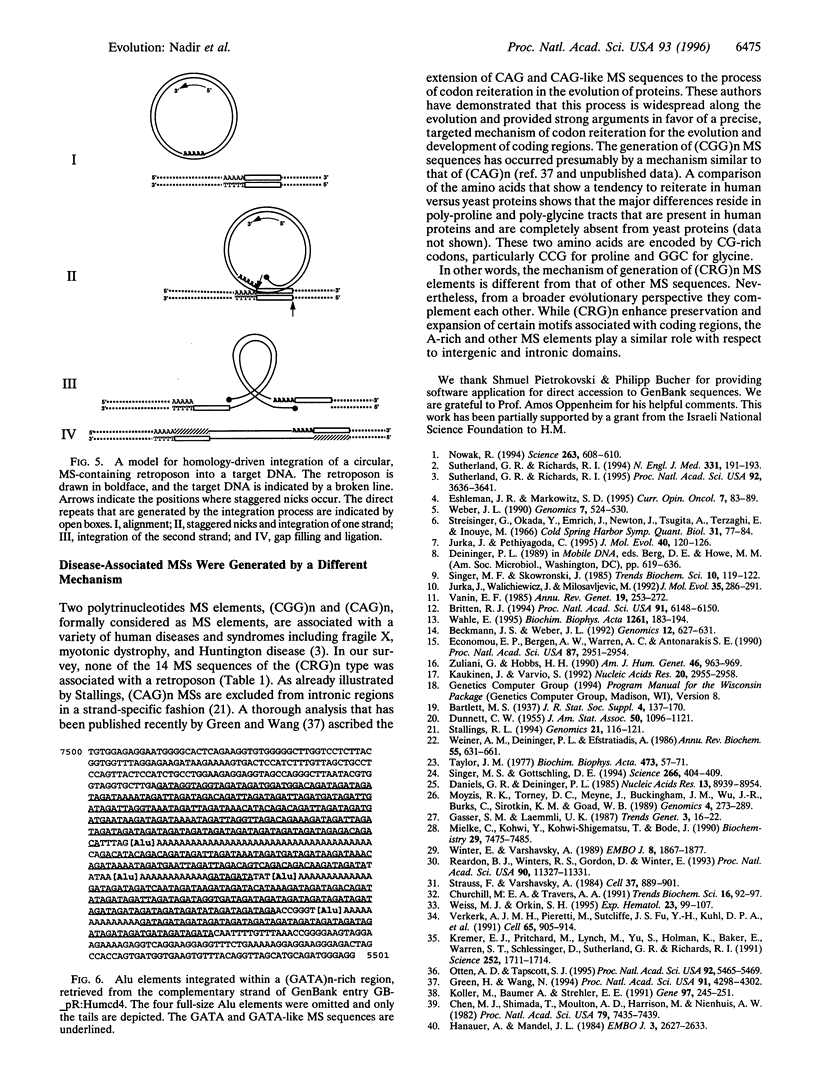
Images in this article
Selected References
These references are in PubMed. This may not be the complete list of references from this article.
- Beckman J. S., Weber J. L. Survey of human and rat microsatellites. Genomics. 1992 Apr;12(4):627–631. doi: 10.1016/0888-7543(92)90285-z. [DOI] [PubMed] [Google Scholar]
- Britten R. J. Evidence that most human Alu sequences were inserted in a process that ceased about 30 million years ago. Proc Natl Acad Sci U S A. 1994 Jun 21;91(13):6148–6150. doi: 10.1073/pnas.91.13.6148. [DOI] [PMC free article] [PubMed] [Google Scholar]
- Chen M. J., Shimada T., Moulton A. D., Harrison M., Nienhuis A. W. Intronless human dihydrofolate reductase genes are derived from processed RNA molecules. Proc Natl Acad Sci U S A. 1982 Dec;79(23):7435–7439. doi: 10.1073/pnas.79.23.7435. [DOI] [PMC free article] [PubMed] [Google Scholar]
- Churchill M. E., Travers A. A. Protein motifs that recognize structural features of DNA. Trends Biochem Sci. 1991 Mar;16(3):92–97. doi: 10.1016/0968-0004(91)90040-3. [DOI] [PubMed] [Google Scholar]
- Daniels G. R., Deininger P. L. Integration site preferences of the Alu family and similar repetitive DNA sequences. Nucleic Acids Res. 1985 Dec 20;13(24):8939–8954. doi: 10.1093/nar/13.24.8939. [DOI] [PMC free article] [PubMed] [Google Scholar]
- Economou E. P., Bergen A. W., Warren A. C., Antonarakis S. E. The polydeoxyadenylate tract of Alu repetitive elements is polymorphic in the human genome. Proc Natl Acad Sci U S A. 1990 Apr;87(8):2951–2954. doi: 10.1073/pnas.87.8.2951. [DOI] [PMC free article] [PubMed] [Google Scholar]
- Eshleman J. R., Markowitz S. D. Microsatellite instability in inherited and sporadic neoplasms. Curr Opin Oncol. 1995 Jan;7(1):83–89. [PubMed] [Google Scholar]
- Green H., Wang N. Codon reiteration and the evolution of proteins. Proc Natl Acad Sci U S A. 1994 May 10;91(10):4298–4302. doi: 10.1073/pnas.91.10.4298. [DOI] [PMC free article] [PubMed] [Google Scholar]
- Hanauer A., Mandel J. L. The glyceraldehyde 3 phosphate dehydrogenase gene family: structure of a human cDNA and of an X chromosome linked pseudogene; amazing complexity of the gene family in mouse. EMBO J. 1984 Nov;3(11):2627–2633. doi: 10.1002/j.1460-2075.1984.tb02185.x. [DOI] [PMC free article] [PubMed] [Google Scholar]
- Jurka J., Pethiyagoda C. Simple repetitive DNA sequences from primates: compilation and analysis. J Mol Evol. 1995 Feb;40(2):120–126. doi: 10.1007/BF00167107. [DOI] [PubMed] [Google Scholar]
- Jurka J., Walichiewicz J., Milosavljevic A. Prototypic sequences for human repetitive DNA. J Mol Evol. 1992 Oct;35(4):286–291. doi: 10.1007/BF00161166. [DOI] [PubMed] [Google Scholar]
- Kaukinen J., Varvio S. L. Artiodactyl retroposons: association with microsatellites and use in SINEmorph detection by PCR. Nucleic Acids Res. 1992 Jun 25;20(12):2955–2958. doi: 10.1093/nar/20.12.2955. [DOI] [PMC free article] [PubMed] [Google Scholar]
- Koller M., Baumer A., Strehler E. E. Characterization of two novel human retropseudogenes related to the calmodulin-encoding gene, CaMII. Gene. 1991 Jan 15;97(2):245–251. doi: 10.1016/0378-1119(91)90058-j. [DOI] [PubMed] [Google Scholar]
- Kremer E. J., Pritchard M., Lynch M., Yu S., Holman K., Baker E., Warren S. T., Schlessinger D., Sutherland G. R., Richards R. I. Mapping of DNA instability at the fragile X to a trinucleotide repeat sequence p(CCG)n. Science. 1991 Jun 21;252(5013):1711–1714. doi: 10.1126/science.1675488. [DOI] [PubMed] [Google Scholar]
- Mielke C., Kohwi Y., Kohwi-Shigematsu T., Bode J. Hierarchical binding of DNA fragments derived from scaffold-attached regions: correlation of properties in vitro and function in vivo. Biochemistry. 1990 Aug 14;29(32):7475–7485. doi: 10.1021/bi00484a017. [DOI] [PubMed] [Google Scholar]
- Moyzis R. K., Torney D. C., Meyne J., Buckingham J. M., Wu J. R., Burks C., Sirotkin K. M., Goad W. B. The distribution of interspersed repetitive DNA sequences in the human genome. Genomics. 1989 Apr;4(3):273–289. doi: 10.1016/0888-7543(89)90331-5. [DOI] [PubMed] [Google Scholar]
- Nowak R. Mining treasures from 'junk DNA'. Science. 1994 Feb 4;263(5147):608–610. doi: 10.1126/science.7508142. [DOI] [PubMed] [Google Scholar]
- Otten A. D., Tapscott S. J. Triplet repeat expansion in myotonic dystrophy alters the adjacent chromatin structure. Proc Natl Acad Sci U S A. 1995 Jun 6;92(12):5465–5469. doi: 10.1073/pnas.92.12.5465. [DOI] [PMC free article] [PubMed] [Google Scholar]
- Reardon B. J., Winters R. S., Gordon D., Winter E. A peptide motif that recognizes A.T tracts in DNA. Proc Natl Acad Sci U S A. 1993 Dec 1;90(23):11327–11331. doi: 10.1073/pnas.90.23.11327. [DOI] [PMC free article] [PubMed] [Google Scholar]
- Singer M. S., Gottschling D. E. TLC1: template RNA component of Saccharomyces cerevisiae telomerase. Science. 1994 Oct 21;266(5184):404–409. doi: 10.1126/science.7545955. [DOI] [PubMed] [Google Scholar]
- Stallings R. L. Distribution of trinucleotide microsatellites in different categories of mammalian genomic sequence: implications for human genetic diseases. Genomics. 1994 May 1;21(1):116–121. doi: 10.1006/geno.1994.1232. [DOI] [PubMed] [Google Scholar]
- Strauss F., Varshavsky A. A protein binds to a satellite DNA repeat at three specific sites that would be brought into mutual proximity by DNA folding in the nucleosome. Cell. 1984 Jul;37(3):889–901. doi: 10.1016/0092-8674(84)90424-0. [DOI] [PubMed] [Google Scholar]
- Streisinger G., Okada Y., Emrich J., Newton J., Tsugita A., Terzaghi E., Inouye M. Frameshift mutations and the genetic code. This paper is dedicated to Professor Theodosius Dobzhansky on the occasion of his 66th birthday. Cold Spring Harb Symp Quant Biol. 1966;31:77–84. doi: 10.1101/sqb.1966.031.01.014. [DOI] [PubMed] [Google Scholar]
- Sutherland G. R., Richards R. I. DNA repeats--a treasury of human variation. N Engl J Med. 1994 Jul 21;331(3):191–193. doi: 10.1056/NEJM199407213310310. [DOI] [PubMed] [Google Scholar]
- Sutherland G. R., Richards R. I. Simple tandem DNA repeats and human genetic disease. Proc Natl Acad Sci U S A. 1995 Apr 25;92(9):3636–3641. doi: 10.1073/pnas.92.9.3636. [DOI] [PMC free article] [PubMed] [Google Scholar]
- Taylor J. M. An analysis of the role of tRNA species as primers for the transcription into DNA of RNA tumor virus genomes. Biochim Biophys Acta. 1977 Mar 21;473(1):57–71. doi: 10.1016/0304-419x(77)90007-5. [DOI] [PubMed] [Google Scholar]
- Vanin E. F. Processed pseudogenes: characteristics and evolution. Annu Rev Genet. 1985;19:253–272. doi: 10.1146/annurev.ge.19.120185.001345. [DOI] [PubMed] [Google Scholar]
- Verkerk A. J., Pieretti M., Sutcliffe J. S., Fu Y. H., Kuhl D. P., Pizzuti A., Reiner O., Richards S., Victoria M. F., Zhang F. P. Identification of a gene (FMR-1) containing a CGG repeat coincident with a breakpoint cluster region exhibiting length variation in fragile X syndrome. Cell. 1991 May 31;65(5):905–914. doi: 10.1016/0092-8674(91)90397-h. [DOI] [PubMed] [Google Scholar]
- Wahle E. 3'-end cleavage and polyadenylation of mRNA precursors. Biochim Biophys Acta. 1995 Apr 4;1261(2):183–194. doi: 10.1016/0167-4781(94)00248-2. [DOI] [PubMed] [Google Scholar]
- Weber J. L. Informativeness of human (dC-dA)n.(dG-dT)n polymorphisms. Genomics. 1990 Aug;7(4):524–530. doi: 10.1016/0888-7543(90)90195-z. [DOI] [PubMed] [Google Scholar]
- Weiner A. M., Deininger P. L., Efstratiadis A. Nonviral retroposons: genes, pseudogenes, and transposable elements generated by the reverse flow of genetic information. Annu Rev Biochem. 1986;55:631–661. doi: 10.1146/annurev.bi.55.070186.003215. [DOI] [PubMed] [Google Scholar]
- Weiss M. J., Orkin S. H. GATA transcription factors: key regulators of hematopoiesis. Exp Hematol. 1995 Feb;23(2):99–107. [PubMed] [Google Scholar]
- Winter E., Varshavsky A. A DNA binding protein that recognizes oligo(dA).oligo(dT) tracts. EMBO J. 1989 Jun;8(6):1867–1877. doi: 10.1002/j.1460-2075.1989.tb03583.x. [DOI] [PMC free article] [PubMed] [Google Scholar]
- Zuliani G., Hobbs H. H. A high frequency of length polymorphisms in repeated sequences adjacent to Alu sequences. Am J Hum Genet. 1990 May;46(5):963–969. [PMC free article] [PubMed] [Google Scholar]



